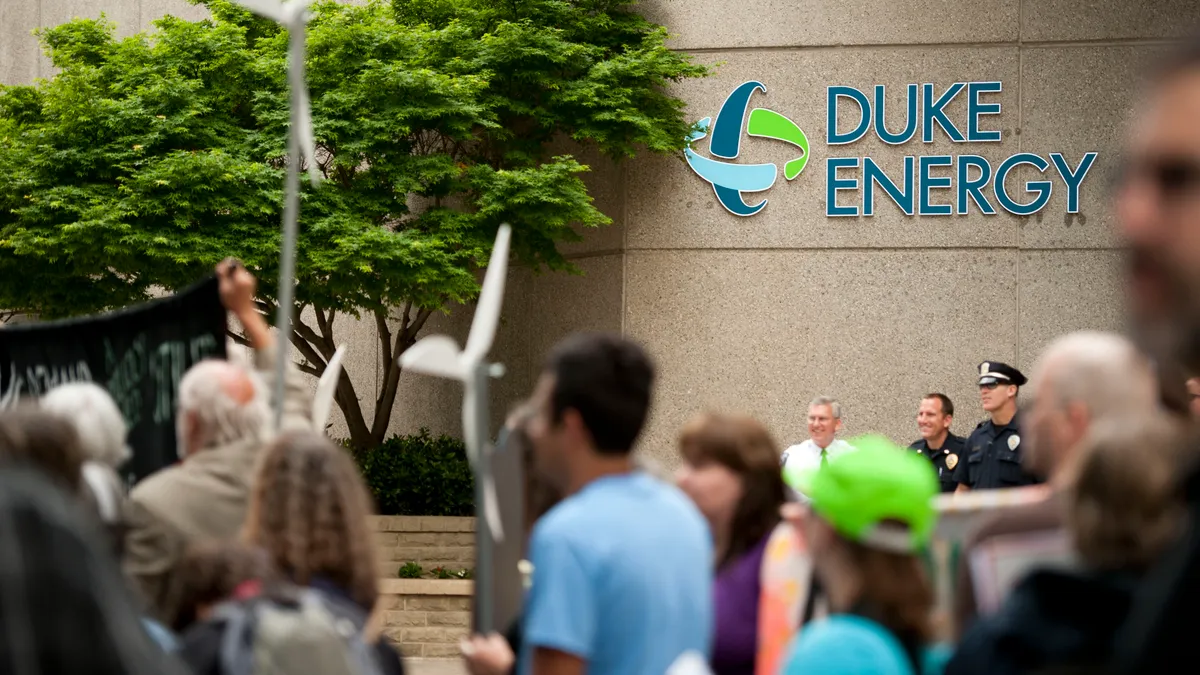Dive Brief:
- Duke Energy is eyeing an early retirement of its coal-fired plants by the end of the decade, according to the revised integrated resource plans (IRP) filed with South Carolina regulators Friday for its subsidiaries, Duke Energy Progress and Duke Energy Carolinas.
- Duke’s revised IRPs also call for adding 3,000 MW of solar energy and 600 MW of wind power over the next 15 years, compared to earlier proposals South Carolina’s Public Service Commission (PSC) rejected in June. Duke's preferred alternative would add 15,500 MW in solar power by 2035, compared to 12,300 MW under a scenario in the earlier proposal.
- However, environmental groups are criticizing Duke’s revised IRPs — essentially blueprints for future power plant development — faulting the reliance of the utility subsidiaries on new natural gas-fired plants to pick up the slack as coal-fired plants are shuttered.
Dive Insight:
The revised plans from Duke Energy Progress and Duke Energy Carolinas come after South Carolina's PSC voted 4-1 in late June to reject the Duke IRPs and send the company back to the drawing board.
The commission, among other items, questioned Duke's estimation of the capacity of solar power to meet South Carolina's energy needs, while also calling on the company to pick a single "preferred alternative" among the several scenarios it presented.
Duke’s revised plan meets the commission’s demands on both points, adding more solar and picking one preferred alternative.
In another big change, Duke’s preferred alternative also calls for shutting down the company’s coal plants by 2030, speeding that process up by more than a decade.
Overall, Duke now plans to reduce carbon emissions by 66% of 2005 levels by the end of the decade.
Dave Rogers, Southeast deputy regional campaign director for the Sierra Club’s Beyond Coal campaign, said the decision to ramp up natural gas-fired power production is a concern.
Duke's preferred alternative in its revised IRPs calls for adding 9,600 MWs of natural-gas fired plants through 2035.
That decision stands in the way of even greater reductions in carbon emissions that would result if Duke were to instead further ramp up its investment in solar and other renewable sources, Rogers said.
"The negatives are it includes way too much gas if we are to avoid the worst impacts of climate change," Rogers said.
Maggie Shober, utility reform director for Southern Alliance for Clean Energy, offered a similar take.
"Duke’s modified resource plans for its two utilities in the Carolinas are a step in the right direction, with more solar than was proposed in its original plan nearly a year ago," Shober said in a press release. "However, Duke is continuing to plan for nearly 10 GW of new gas plants."
But the Duke Energy Carolinas IRP offers a different perspective, arguing that natural gas is a "necessary flexible and dispatchable resource" needed to ensure reliability as more variable, weather-dependent renewable sources are brought online.
In addition, Duke said the new natural gas generators it proposes building will be cleaner, using a minimum of 30% hydrogen, with the potential to shift to 100% by 2030.
Without natural gas as a bridge, Duke contends it will be forced to rely on renewable energy storage systems and other emerging technologies that "may not be commercially available or economic … to meet customer demand growth and allow for the reliable replacement of retiring coal generation."
A spokesperson for Duke Energy cautioned that the preferred alternative outlined in its IRP "is directional in nature" and that the utility is "not moving toward execution of this specific plan at this point in time."
Further analysis will be needed to "evaluate the optimal coal retirement schedule and generation replacement options," the spokesperson said in an email.
"Efficient new natural gas continues to be necessary as a flexible resource to ensure continued grid reliability as the company transitions to higher levels of intermittent carbon-free resources," the spokesperson stated.













